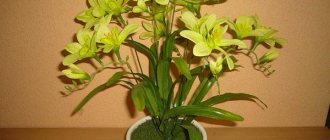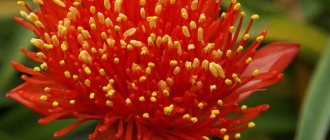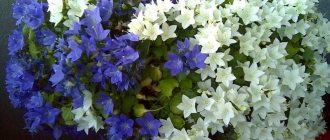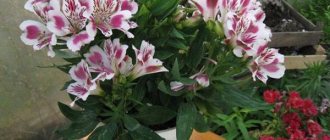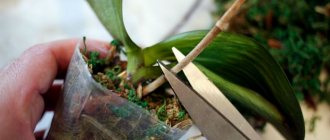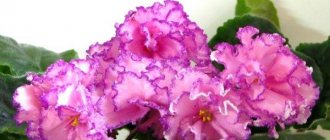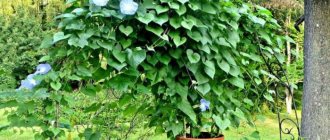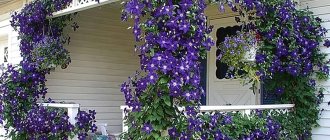Caladium is a deciduous indoor plant from the Araceae family. In nature, it is distributed in the tropics of South America and India.
Caladium gained popularity as an indoor flower for its incredibly beautiful light green leaves with various stains, spots and contrasting patterns. Due to the unusual coloring and shape of the leaves, the crop in nature is called “Angel Wings”, “Heart of Christ” and Elephant Ears. The shoots of caladium are very thin, most often basal, arrow-shaped or heart-shaped. The plant requires careful attention and some care. Indoor caladium does not grow too quickly - from 10 to 12 leaves appear during the growing season, and the flower itself reaches a height of 30 to 60 cm, and in nature the crop grows up to 5 meters.
A peculiarity of cultivation is a seasonal dormant period, during which the caladium completely loses its leaves and “freezes,” so it is most often grown as an annual.
| In one year, the plant adds 10-15 leaves. |
| At home it hardly blooms. |
| The plant is easy to grow. |
| Up to 3 years. |
Photo gallery
Magnificum (Magnificum)
This is a real “zebra” of the plant world. Just 2 colors are enough - white and green - for the plant to acquire a completely unusual color. And the Magnificum variety is the best proof of this. The variety belongs to the Linden species (lindenii), which was bred back in 1858 in Brazil. The leaves of the plant are oblong in shape, with pointed ends.
| Leaf color | Height (cm) | Peculiarities |
| White-green stripes | 20-25 | Withstands temporary waterlogging of the soil |
Description of the plant
Caladium belongs to the Araceae family and lives in tropical and subtropical zones of South America, mainly in Brazil. This plant first came to Europe in 1800 thanks to the French botanist Pierre Ventana.
Caladium is literally translated from the native dialect as “a plant that has edible roots.” Because of the amazing beauty of its leaves, it is called “angel wings”, “elephant ears” and “heart of Jesus”.
It is a herbaceous perennial plant. In its natural environment it reaches 5 meters in height, and its arrow-shaped leaves can replace an umbrella for local residents during rain. The life cycle of caladium is clearly divided into periods of dormancy and active growth. In March, young shoots form, which begin to dry out at the end of summer.
Often, inexperienced gardeners fail to bring it out of hibernation, and they refuse to grow it.
In some countries, certain types of caladium are used as a vegetable crop, since the tubers contain a lot of starch. The sap of indoor hybrid plants is poisonous - if it comes into contact with the skin and mucous membranes, it can cause a burn. Therefore, it should be placed in places inaccessible to children and animals. It is recommended to perform all care procedures with rubber gloves.
Coleus is similar in leaf shape and color to caladium. In terms of beauty and color, you can find a certain similarity with decorative begonia. His “elephant mugs” also resemble syngonium. However, the conditions of detention and the size of the crops are radically different.
The base of the plant is a tuber, it has a rough surface and a rounded shape. It grows about 7-12 cm in diameter. A fibrous rhizome is formed from it, on which buds form.
Like all representatives of the Araceae, the inflorescence looks like an ear surrounded by a veil and is no different in beauty. Small white buds appear on the peduncle in early spring, after the first leaves have formed. Flowering continues for several days, there is no aroma.
The leaves are valuable to florists:
- the size reaches 30 cm long and 15-17 wide;
- located on small cuttings;
- grow in the form of a rosette directly from the tuber;
- the shape of the leaf blade resembles a heart;
- On the surface there are drawings of various shapes, colors and sizes.
The lifespan of greenery reaches 5-6 months, and at the beginning of autumn they wither and a long period of dormancy begins for the plant.
Benefits and harms
Caladium has poisonous juice , so it should be kept away from children, and your hands should be protected with gloves when caring for it. Residents of this plant’s homeland used its tubers for food, which is why it has the name “plant with an edible root.”
Flower growers should also pay attention to such representatives of bushy plants as murraya, palisota, polyscias, arrowroot, nightshade, aucuba, strobilanthes, colocasia and kufeya.
Signs and superstitions
“Colors are the smiles of nature,” said the popular 19th century writer James Hunt. A person surrounds himself with those colors and colors that help achieve harmony and mental balance. Green leaves with a bright red caladium pattern inspire you and give you confidence in your own abilities. Indoor plants are a symbol of life; they humidify the air and saturate it with special energy and oxygen.
There are no negative superstitions associated with caladium; it is not considered an energy vampire. The only danger is the toxicity of its juice.
Plants, according to the Taoist teachings of Feng Shui, must be placed strictly in the southern parts of the rooms, ideally this would be in the kitchen or living room. In this case, pots must be placed at a distance from people.
For lovers of compositions in the form of bonsai, caladium will not be suitable for sure, since its aesthetic qualities lie in a lush bush. And also biological properties (lack of a stem) will not allow creating such a form.
Possible difficulties during cultivation
When cultivating caladium at home, plant growers may encounter the following diseases:
- Late blight is a fungal disease that begins to progress in a warm, humid environment. The fungal spores that cause the disease quickly spread to neighboring plants. When the first symptoms appear, you need to remove the damaged leaves, carry out an urgent transplant, completely replacing the earthen ball. Carry out three treatments with copper sulfate with an interval of 10–14 days.
- Bacterial rot - the disease is caused by high soil moisture. The plants are urgently replanted, rotten roots are removed and treated with the dry insecticide “Fundazol”. Then they are replanted, burying the bulbs in the soil no more than 3–6 cm.
Among the pests that are most dangerous for caladium are:
- aphid;
- mealybug;
- spider mite
Insecticides are used to control pests. First, insects are collected by hand, then they are treated with Aktara. For 10 liters of water take 20 g of the substance. Caladium is an interesting tropical representative. In our latitudes, it is grown at home as an ornamental foliage plant. High maintenance requirements.
Home care
During the growing season, the optimal temperature for the plant is 22-25°C. And during the rest period, the thermometer mark should not fall below 16 °C. Caladium can grow in the shade, but in this case the bright shade of the leaves will disappear. Intense diffused sunlight will allow the flower to show all the beauty of its variegated foliage.
Window sills oriented to the north, northeast and northwest will be best for it. In summer, it is allowed to take the pot outside, but it must be placed in partial shade, where there are no drafts.
A tropical guest needs to create a similar microclimate. Air humidity for caladium should be at 70%. This can be achieved by placing a tray with wet expanded clay or moss under the pot.
You cannot spray it - drops of water will lead to the appearance of brown spots; you can spray moisture into the air near the flower.
The peculiarity of the plant is the need to prepare it for the dormant period and special care in winter:
- In August you should stop feeding.
- From the moment the grass shoots begin to dry, you need to reduce watering.
- There is no need to trim dry stems; the resting phase begins in November.
- It is recommended to dig up the tubers and move them into a dry mixture of peat and sand.
- The soil should be slightly moist, this can be achieved by spraying.
Diseases and pests
Caladium is a fastidious plant that instantly reacts to improper care, violation of the watering schedule and changes in room temperature. The following problems may arise in growing this variegated flower:
- Caladium leaves curl - you need to find a warmer place to place the plant.
- Leaves that are brown and dry at the edges mean there is not enough moisture, you need to change the watering regime.
- Mold on leaves - excessive soil moisture, possible appearance of aphids.
- Caladium leaves are fading - there is not enough light, the air in the room is too dry.
- Caladium leaves die off - this is a natural process during which new shoots appear on the flower, but if the leaves die off on a massive scale, you need to feed the plant with mineral fertilizer with nitrogen.
- Caladium leaves become discolored due to lack of light.
- The leaves turn yellow and dry out - during the active growing season, this manifestation is a consequence of improper watering and lack of fertilizers. If this happens in the fall, then the plant is simply preparing for a dormant period.
- Dried edges of leaves - exposure to sunlight, improper placement, improper watering.
- Caladium grows poorly or has small leaves - you should choose the right composition of the mineral fertilizer and find a more illuminated place to place the flower.
If improperly watered, caladium tubers can quickly rot. Having taken them out of the soil, you need to inspect them for the presence of rot. If the tubers are soft and turn yellow, the flower is dead.
Caladium is often attacked by harmful insects. Most often, he becomes a “victim” of an attack by spider mites, aphids, and mealybugs. You can fight harmful insects by spraying the leaves with insecticides.
Soil selection
The substrate for caladium needs to be light, with good access of oxygen to the roots. Ready-made soils for Dieffenbachia and spathiphyllum are suitable. The optimal acidity level is about 6 pH. You can make a soil mixture at home from the following components (in the ratio 1:1:1:0.5):
- peat;
- leaf soil;
- humus;
- sand.
To prevent rot from occurring, the bottom of the pot must be drained to 1/4 of the volume. You can use expanded clay for this.
Treating the soil with a solution of potassium permanganate or copper sulfate will help get rid of pests before planting.
Growing caladium at home
Those who want to grow caladium on their own need to know what care this crop requires at home. Since caladium is a variegated plant, it requires a lot of light.
But direct sunlight can destroy it. In normal, tropical conditions, caladium is protected from direct rays by the crowns of other plants. To protect it from the scorching sun in the house, you need to choose the right location.
Pots with these flowers should be placed on windows facing west or east. If this is not possible, and the plant is placed on a south window, it must be darkened. To grow caladium in a north-facing window, you need to provide additional lighting.
Having a tropical origin, indoor caladium is highly dependent on factors such as air humidity. In summer, under natural weather conditions, he feels quite comfortable. But during the cold period, when the room is warmed up with the help of heating devices, it is necessary to provide additional air humidification.
Caladium reacts to spraying leaves by changing color and appearing spots, so this should not be done. You need to spray water over the plant.
From the start of sprouting until the caladium goes dormant, it requires plenty of watering. It is necessary to water at the first signs of drying out of the top layer of soil.
The lack of water is instantly reflected on the leaves of the plant. They become lethargic and lose all their beauty. But you can’t overdo it either. Excessive watering will cause root rot and plant death.
The indoor caladium plant should be planted in a mixture of peat, humus and garden soil in equal parts.
You can mix in a small amount of crushed coal, sphagnum and fine sand. The soil must be sterilized and laid out on a drainage layer.
Containers for caladium are selected depending on the size of the tuber. For small ones, a pot of 10-12 cm in diameter is enough. A large tuber will require a container with a diameter of more than 20 cm.
Selecting a location
The brighter the colors of the caladium leaves, the more diffused light it needs. The plant does not tolerate direct sunlight, which can cause severe leaf burns.
The best place for “angel wings” is a window in the northeast or northwest. Throughout the year, caladium feels good at temperatures from +18 to +25 °C.
Lighting, air humidity
Caladium loves diffused light. With little sunlight, the color of the leaves becomes less bright and saturated. It is good if the window where the plant is located is oriented to the western or eastern sides. On a northern window sill, if there is insufficient light, you can use special phytolamps, which are available in a wide range in specialized stores.
Optimal air humidity is about 70%. The leaves need to be wiped from dust from time to time and sprayed with a spray bottle, especially in dry weather or when exposed to direct sunlight.
Temperature
During the active period, caladium, like other tropical plants, loves humidity, warmth and does not tolerate drafts and cold. The optimal temperature for growing caladium is from + 15 to +26 degrees Celsius. During rest, the optimal temperature will be from + 15 to + 20 degrees Celsius. Sharp temperature fluctuations are unacceptable in any season.
Soil for caladium
Any neutral one that has sufficient nutritional value and good drainage will do.
The growing season requires weekly feeding. The fertilizer selected is a complex mineral one. When watering ends, fertilizing is stopped.
Top dressing
During active growth, caladium will not refuse a weekly portion of complex mineral fertilizer. During wintering, the plant is not fertilized.
Watering
From the beginning of the growing season until the end of summer, the plant requires a lot of moisture. Watering is carried out as soon as the top layer of soil dries. Water needs to be soft, settled, and at room temperature. Watering is very important to maintain decorativeness; An overdried plant will become dull. But it is impossible to over-water the caladium, as the tuber easily rots. At the end of summer, watering is gradually reduced, causing the foliage to wilt. After they completely fall off, watering is stopped.
The humidity must be quite high. To create the desired microclimate, use a household steam generator or place the plant in a florarium. Spraying will result in unsightly spots on the foliage.
Spraying
High air humidity is required. Place the pot on a tray of damp pebbles or use a room humidifier. Spraying is not recommended. Does not like cold drafts, but it is worth providing for good air movement around the plant.
Transfer
In very early spring, caladium needs annual replanting. In proportion to the tuber, select a container and fill it with new soil. Small nodules are planted spaciously in one large pot. Tubers are planted in 2 ways: to grow a lush bush, they are deepened by 4 inches, and to get children, they are lightly dug in. After planting, it is not recommended to water the caladium; you only need to lightly moisten the soil. As foliage appears, watering is increased.
Trimming
Pruning is contraindicated for caladium; after growth ends, the leaves fall off on their own. It is imperative to remove them from the pot so that they do not start to rot.
Rest period
The most important information needed by every flower lover who decides to start a caladium is how to organize the dormant period that is vital for the plant.
All summer, caladium grows and develops in normal conditions, characteristic of other indoor plants. But gradually, starting in September, caladium needs to prepare for a period of rest. At this time, watering the plant is gradually reduced and feeding with mineral fertilizers is eliminated.
Then, in October, the caladium is prepared for wintering. The exact time of the start of the dormant period will be indicated by the plant itself - if massive drying out and falling of leaves begins, then it’s time.
Preparation for the dormant period occurs as follows: the fallen dry leaves are removed, while the leaves remaining on the plant must be preserved, and the tubers of the plant are laid for winter storage.
The plant can be stored either in pots or in another way - after the leaves fall off at the end of the season and the substrate dries, the tubers can be removed from the bowl and shaken off the ground. After that, put it on the windowsill under a lamp for a week. The air temperature should be about + 20 degrees Celsius. Then you need to put the tubers in a bag with moss, perlite or sand in a dark and warm place; they can be planted again in the spring.
[!] Before replanting, the tubers must be carefully checked. They should be free of fungus, mold, various diseases and pests, otherwise all the work will be in vain.
The air temperature in the room in which wintering caladiums are stored is very important. It should be approximately 18-21 degrees Celsius. If the temperature drops below 15 degrees, there is a high probability of various diseases appearing on the tubers. And at a temperature of 10 degrees, caladium may even die.
Caladium care during the dormant period
When caring for caladium at home, you need to take into account that these plants have a mandatory dormant period, which in the middle zone occurs in autumn-winter.
By September, in order to prepare the tubers for hibernation, the intensity of watering is gradually reduced. After this, the foliage begins to wilt and fall, meaning that moisture is no longer needed at all.
Dried caladium tubers in autumn:
- removed from the ground;
- Carefully clean off any remaining substrate and dried roots.
- inspected for damage, rot or signs of disease.
All damaged tissue is removed, and the cut sites are treated with a fungicide and, after drying the preparation, sprinkled with crushed activated carbon.
The tubers overwinter in dry moss or vermiculite at room temperature until, in January or February, a growth bud becomes clearly visible at the top, ready to give birth to a new rosette of leaves.
Reproduction
Caladium grown from seeds often does not retain varietal characteristics. They begin to bloom on a flowering plant without artificial pollination, but quickly lose their germination capacity; sowing is allowed for the next season. The procedure is carried out in the following order:
- sowing is carried out in February in a nutritious soil mixture of leaf soil and sand in a ratio of 1:4;
- the substrate should be moistened and the seeds should be slightly buried;
- cover with film to create a greenhouse effect;
- germination must occur at a temperature not lower than 25 °C;
- regularly ventilate and moisten the soil.
The first shoots appear 15-20 days after planting. After the formation of the first 2 leaves, the seedlings must be picked and planted. Repeated transplantation is needed at the end of spring. By autumn, small tubers are formed, from which a fully formed plant grows the next season.
The easiest way to propagate caladium is by tubers. This should be done in February-March. Several division methods are possible:
- the mother tuber must be divided into parts so that two buds are preserved on each part;
- by children - separated and grown as a separate plant.
The separation tool must be sharp and sterile. The cut must be treated with charcoal to prevent rotting. A soil mixture of sand and peat is suitable for germinating tubers.
Care errors
If you do not follow all the recommendations for caring for caladium, various problems will begin to arise with the plant:
- The leaves curl. Because of the cold in the room. Should be moved to a warmer place.
- The edge of the leaf turns brown. The pet does not have enough moisture. Increase the watering regime.
- Mold appeared on the leaves. If there are no aphids, then water is constantly stagnating in the flowerpot. Take action.
- The leaves are withering. Due to low air humidity or lack of light.
- The leaves are dying. If a new one soon appears in place of a dead leaf, this is a natural process. But if massive drying of the leaf blades occurs, it means that the bush does not have enough minerals, especially nitrogen. It should be fertilized.
- The foliage is fading. Move the flowerpot with angel wings closer to the window - there is not enough light for it.
- Yellowing of leaves. It happens due to untimely watering of the plant or lack of nutrients. There is no need to worry in the fall - the pet is simply preparing for a state of rest.
- Dried edges of leaves. Move the pot out of direct sunlight.
- The leaves are getting smaller. Move your pet closer to the light source.
Fertilizer application
It is necessary to start feeding caladium in June, after the shoots stop growing. The plant needs balanced chemical fertilizers, which should contain phosphorus, potassium and nitrogen in equal parts. Organic fertilizers include manure, litter, compost, humus (contain nitrogen), and wood ash is rich in potassium and calcium.
It is recommended to use universal mixtures for decorative foliage plants (such as Bona Forte, Agricola Aqua). It must be diluted in accordance with the instructions; lower concentrations are allowed. Nutrients must be added alternately once a week throughout the growing season. From August until the next season, feeding the flower is not required.
Excess nitrogen leads to a color change - green will prevail over the red tint.
Life cycle of caladium
Caladium is a seasonal plant, “active” from late spring to autumn. In autumn, caladium leaves begin to dry out and fall off - which means it’s time to hide your caladium in a secluded place until next spring. Caladium will hibernate comfortably in a dark place - under your bed, in a dark closet. But don't hide the caladium too far away - you should bump into it from time to time so you don't forget to water it. Dry soil is a sure sign that it’s time to water the dormant caladium!
In spring, caladium needs to be removed from the “den”. Carefully inspect the plant tubers for affected and diseased areas. Dead tubers must be removed and the wounds sprinkled with charcoal. Living tubers need to be transplanted into fresh substrate mixed with charcoal. Caladium tubers should be planted to a depth equal to the diameter of the tuber. After planting, water the soil thoroughly. Cover the pot with an opaque bag - caladium likes to wake up in a dark and well-moistened place. Periodically, the bag must be removed to allow the soil to breathe. As soon as the first shoots appear, the bag should be removed so that your caladium gets used to the ambient temperature. Also, do not forget to spray and water the young plant, but do not overdo it: too much and frequent watering can rot the tubers.
Watering
The tropical flower loves regular watering. It is recommended to carry it out in small quantities, avoiding stagnation of water. The need for irrigation can be determined by the drying of the top layer of soil. Abundant watering begins after shoots appear and is reduced in August. During hibernation, spraying is necessary to prevent the tubers from drying out.
Soft water is needed, its temperature should be slightly higher than the environment.
The right soil
For planting, choose nutritious, loose soil. You can make it yourself by mixing: ordinary garden soil with peat and humus. It is allowed to add a small amount of coal and sand.
Choose the optimal size of pots, the diameter of which will be 10 cm.
Types of caladium with photos and names
The Caladium genus includes 15 main species, on the basis of which many varieties have been developed by breeders. They are different in size and color. Popular:
- Humboldt (caladium-humboldtii). It consists of a rosette of arrow-shaped leaves up to 10 cm long and about 5 cm wide. On the dark green surface of the leaves there are silvery spots in the center. The miniature variety Myriostigma has white speckles on the surface.
- Schomburg (Caladium schomburgkii). It is distinguished by oval, heart-shaped burdocks that grow up to 15 cm in length and up to 10 in width. The leaves, depending on the variety, can have a green (Venosum variety) or red (Erythraeum variety) base, on which there is a silver or yellow vein pattern.
- Bicolor (Caladium bicolor). The leaf blade reaches 30 cm in length. The Rosalie variety attracts with a bright green border on a red background. The Florida Cardinal hybrid has shiny crimson leaves with a bright green stripe along the edge. White Christmas is unique with its silvery surface with dark green stripes along the veins and spots.
Kinds
Caladium bicolor
The photo shows the appearance of “caladium bicolor”:
Its leaves have a double color - a red center against a background of dark greenery
Caladium esculentum
Photo of the species “caladium esculentum”:
Significantly differs from other varieties in the height of leaf petioles. They grow up to 100 cm and have huge leaves up to 80 cm.
Caladium violaceum
The photo shows the species “caladium violacecum”:
It is distinguished by a slightly bluish tint of leaves with a red or lilac lower part.
Caladium hybrid
The photo shows a “hybrid caladium”: This variety has an almost white leaf pierced with reddish veins, and a green mesh seems to be draped over the top.
Transfer
Caladium will be happy with any nutritious soil with a neutral pH that allows air and water to pass through well. If desired, you can make a special mixture for this plant from:
- 1 part leaf soil;
- 1 part humus soil;
- 1 part peat;
- 0.5 parts coarse sand.
The plant will also respond favorably to heather soil, pine bark mulch and greenhouse soil. Sometimes caladium is grown in peat.
In February or March, after each dormant period, it is necessary to plant the plant tubers in fresh soil.
The container for planting must correspond to the size of the tuber: if its diameter is from 1 to 3 cm, a pot with a width of 9 to 12 cm is used, and if the tuber is from 4 to 6 cm, a pot with a width of 17 to 19 cm is used.
Several small nodules can be planted in one flowerpot that is free enough for their growth. The tuber should be planted with the pink bud facing up.
If you want to get a large number of “babies” by autumn, you need to place the tuber shallowly, digging it into the ground.
If the goal is to grow a beautiful and voluminous bush, the tuber is buried to a depth of 5 to 10 cm. This helps awaken dormant buds and the appearance of many new leaves.
After planting and before the first leaves appear, watering should be minimal - only light moisture. Next, the plant is watered as usual.
Rest period
Absolutely any caladium needs a six-month wintering . In mid-latitudes, the plant goes dormant in September or October. From this moment on, the caladium loses its leaves and “goes into hibernation.” The minimum temperature at this time is about +18 °C.
During wintering, the tubers can be kept in dry soil or placed in a box with sawdust, sphagnum moss or vermiculite. In the latter case, you must first clear them of soil and remove old roots.
If rotting , it is necessary to cut out the sore spots and treat the sections with crushed coal. In mid-January, a strong growth bud is formed, and in February the plant can already be planted in the ground.
Use in your garden design
Caladiums make beautiful bright flowers in a shady garden. If you like lots of color and wonderful patterns on the foliage of your plants, then caladium tubers are for you. They grow very quickly and have continuous foliage color for months. Grouped together, they can look like they are blooming. Those with white leaves will catch every flicker of light and brighten up any shady corner.
Caladium flowers grow equally well in containers or in the ground. They pair well with ferns and other soft-textured plants such as astilbe, as well as thorny plants such as ornamental grasses and shade-tolerant iris.
Caladium plants tolerate high heat and humidity well since it is a tropical plant. They are relatively low maintenance, but when they receive the best plant care, you may be rewarded with caladium flowers.
The plant grows in South and Central America. In the flower's description, their natural habitat is open areas of forest and along river banks.
Mature size
Most caladium varieties grow to 45-60 cm in height, however there are some dwarf varieties that reach a peak of 20-30 cm. The width of your plant depends on the variety and age.
Caladiums grown as annuals and kept as tubers over the winter will not become as lush as caladium plants left in the ground or grown as houseplants.
